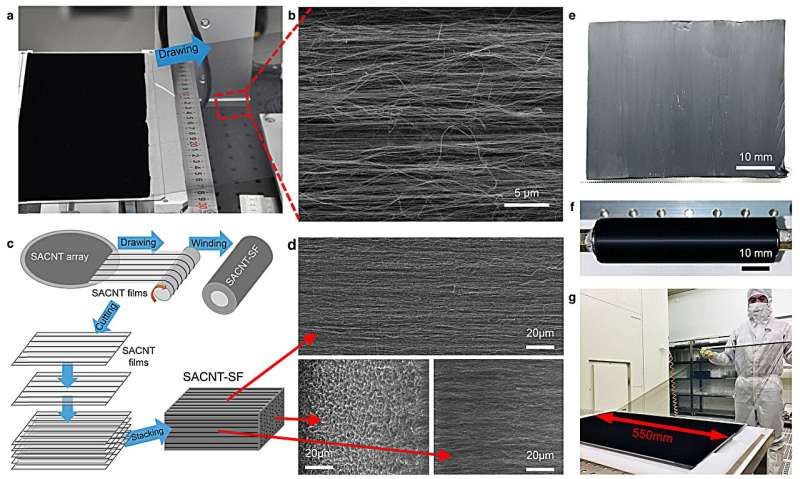Chinese researchers at Tsinghua University have unveiled a groundbreaking material that could change how we protect spacecraft, hypersonic vehicles, and jet engines from extreme heat. The new super-aligned carbon nanotube film (SACNT-SF) acts as a record-breaking thermal insulator, withstanding temperatures up to 2,600°C (4,712°F), far beyond what today’s materials can endure.
Unlike bulky conventional insulators, this futuristic material is lightweight, flexible, and thinner than paper, yet it blocks heat more effectively than anything else developed so far.
How It Works
- Nanostructure: SACNT-SF is created by stacking ultrathin sheets of carbon nanotubes into silk-like layers.
- Heat Blocking Mechanism:
- Conduction: The sparse, porous structure leaves very few solid pathways for heat to travel.
- Radiation: The nanotubes absorb and scatter infrared radiation, a key driver of heat transfer.
- Gas Insulation: The nano-scale gaps restrict the movement of gas molecules, further cutting heat flow.
- Exceptional Numbers:
- At room temperature, SACNT-SF has a thermal conductivity of just 0.004 W/mK — lower than air.
- At 2,600°C, it still insulates at 0.03 W/mK, outperforming all reported thermal insulation materials.
Potential Applications
- Space & Defense: Heat shields for spacecraft re-entry and hypersonic aircraft that endure extreme temperatures.
- Energy & Industry: Thermal protection in jet engines, nuclear reactors, and industrial furnaces.
- Electronics: Its flexibility allows wrapping around complex systems and components that need thermal shielding.
The Catch
One limitation remains: SACNT-SF oxidizes above 500°C in oxygen, which restricts its direct use in air. For now, it works best in oxygen-free environments, such as space or inert-gas atmospheres. The Tsinghua team is already working on protective coatings to extend the usability of these coatings in engines and reactors exposed to oxygen.
Beyond Heating Point
High-temperature insulation has long been a bottleneck for aerospace and energy technologies. Most existing materials either fail beyond 1,500°C or require heavy, bulky layers to be effective. SACNT-SF breaks that barrier, offering a thin, feather-light solution with record-setting performance.
If scalable, this carbon nanotube innovation could redefine what’s possible in space travel, defense technology, and next-generation energy systems.


